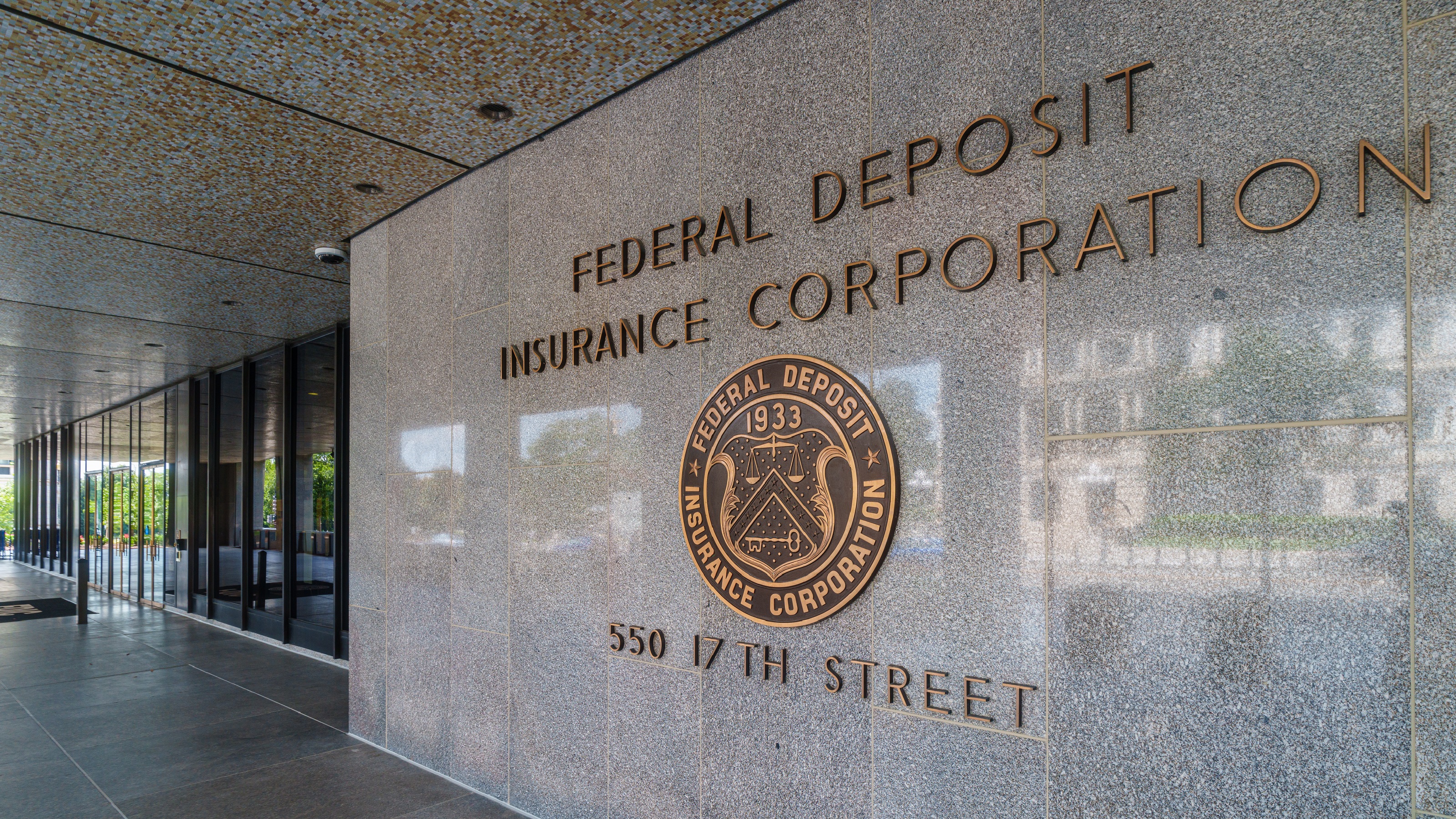The FDIC Is From the Government and Really Is Here to Help
The FDIC has spent more than nine decades in action, so let's take a look at what it does and why it's so important for consumers.


There are a lot of people — especially older Americans — who do not trust the stock market or simply do not want to have their retirement funds at risk of the kinds of losses that can hit the markets. And so they place their money in various accounts at banks insured by the FDIC, the Federal Deposit Insurance Corporation.
This incredibly important, independent agency of the United States government celebrated its 90th anniversary last year, protecting bank depositors against the loss of their insured funds in the event their bank or savings association fails.
It is important to understand how the FDIC has proven itself critical to the stability of our banking system and — no exaggeration — our financial system.

Sign up for Kiplinger’s Free E-Newsletters
Profit and prosper with the best of expert advice on investing, taxes, retirement, personal finance and more - straight to your e-mail.
Profit and prosper with the best of expert advice - straight to your e-mail.
Let’s take a look at why and when the FDIC was established. Two words help explain why: bank run.
What is a bank run?
A bank run occurs when a large group of depositors — fearing their bank will become insolvent — withdraw, or attempt to withdraw, their money at the same time. We’ve all seen photos of thousands of people in long lines, hoping to get their money out of banks during the Depression in the 1930s and the Great Recession in 2008.
As only about 13% of a bank’s assets are in cash, that can quickly be depleted. If the institution can’t sell assets quickly enough to meet depositors’ deposit demands, failure can result. During the Depression, more than 9,000 banks failed, replacing many families’ life savings with poverty and fear. Billions of dollars evaporated.
There was no national deposit insurance system in the U.S. at that time.
Recognizing the need to protect bank depositors, President Franklin Roosevelt signed the Banking Act of 1933 (aka the Glass-Steagall Act) into law, creating the FDIC. Funded not by taxpayers, but through assessments on banks themselves, the FDIC’s mission is to “maintain stability and public confidence in our nation’s financial system.”
How does the FDIC work? What is and isn’t covered?
Unlike other types of insurance, where you have to pursue and pay for coverage, the simple act of opening a deposit account at an FDIC-insured bank or financial institution automatically covers your deposits.
Here are examples of deposit products insured by the FDIC:
- Checking and savings accounts
- Certificates of deposit (CDs)
- Money market deposit accounts
- Prepaid cards, cashier’s checks, money orders and other official items issued by a bank
- Negotiable order of withdrawal (NOW) accounts
However, the following are not insured, even if purchased through an FDIC-insured bank:
- Stock, bond and mutual fund investments
- Crypto assets
- Life insurance policies
- Annuities
- U.S. Treasury bills, bonds or notes
- Municipal securities.
- Contents of safe-deposit boxes
What are the limits of coverage?
Of course, virtually every type of insurance has limits of coverage (how much will be paid in the event of a covered loss). To learn how this works with insured bank products, I spoke with Washington, D.C.-based Martin Becker, chief of Deposit Insurance at the FDIC.
“Deposits are insured for up to $250,000 per depositor, per account ownership category, per FDIC-insured bank,” Becker points out. “And the limits of coverage increase by $250,000 with additional beneficiaries on the account, up to a maximum of $1.25 million under the trust category, at one institution. Recently, we have simplified the rules for trusts. For your readers with large amounts of money wanting FDIC protection, this is certainly possible if the accounts are correctly set up. The FDIC has an online tool, EDIE, that has been used by millions of consumers to determine their coverage. I also recommend spending time on (the area of) our website that explains FDIC deposit insurance ownership categories.
“Additionally, we have customer service representatives who are able to answer your questions. Just call 877-275-3342 (877-ASK-FDIC).”
Recent FDIC coverage changes limit the number of beneficiaries
Timing is everything, and the day after my interview with Becker, 89-year-old “Martha” phoned my office, upset. “Mr. Beaver,” she said, “I have a great deal of money in a bank savings account with eight family members as beneficiaries for when I die. A financial adviser I met last year just called and told me that the FDIC coverages had changed and I needed to meet with him to discuss placing some money in stock market investments. Is that correct?”
“Martha, what you were told is nonsense! Yes, the FDIC did make some changes, but nothing requires you to get into the stock market. Each (trust) account owner is insured up to $250,000 for each beneficiary, with a maximum of five beneficiaries and a total of $1.25 million insured, per financial institution.”
I related to Martha what Becker advised in this situation. “Simply open an additional (trust) account at a different FDIC-insured bank, or at several FDIC-insured banks,” if her deposits exceed $1.25 million. For example, she could split her eight beneficiaries among different FDIC-insured banks, ensuring that each trust account does not exceed $1.25 million.
The people at the FDIC really are from the government and are here to help.
Dennis Beaver practices law in Bakersfield, Calif., and welcomes comments and questions from readers, which may be faxed to (661) 323-7993, or e-mailed to Lagombeaver1@gmail.com. And be sure to visit dennisbeaver.com.
Related Content
Get Kiplinger Today newsletter — free
Profit and prosper with the best of Kiplinger's advice on investing, taxes, retirement, personal finance and much more. Delivered daily. Enter your email in the box and click Sign Me Up.

After attending Loyola University School of Law, H. Dennis Beaver joined California's Kern County District Attorney's Office, where he established a Consumer Fraud section. He is in the general practice of law and writes a syndicated newspaper column, "You and the Law." Through his column, he offers readers in need of down-to-earth advice his help free of charge. "I know it sounds corny, but I just love to be able to use my education and experience to help, simply to help. When a reader contacts me, it is a gift."
-
 Ten Cheapest Places To Live in Florida
Ten Cheapest Places To Live in FloridaProperty Tax Make your Florida vacation spot daily living — these counties have the lowest property tax bills in the state.
By Kate Schubel
-
 I'm 50 and my home is worth $5 million. Can I retire now?
I'm 50 and my home is worth $5 million. Can I retire now?It may be oh-so tempting to cash out your upscale home and leave work for good. But should you? We ask the experts.
By Maurie Backman
-
 I'm 50 and My Home Is Worth $5 Million. Can I Retire Now?
I'm 50 and My Home Is Worth $5 Million. Can I Retire Now?It may be oh-so tempting to cash out your upscale home and leave work for good. But should you? We ask the experts.
By Maurie Backman
-
 Tesla Stock Pops as Elon Musk Promises DOGE Draw Back
Tesla Stock Pops as Elon Musk Promises DOGE Draw BackTesla reported a sharp drop in first-quarter earnings and sales, as the EV maker suffered a backlash to its CEO's political ambitions.
By Karee Venema
-
 Bouncing Back: New Tunes for Millennials Trying to Make It
Bouncing Back: New Tunes for Millennials Trying to Make ItAdele's mournful melodies kick off this generation's financial playlist, but with the right plan, Millennials can finish strong.
By Alvina Lo
-
 Early-Stage Startup Deals: How Do Convertible Notes Work?
Early-Stage Startup Deals: How Do Convertible Notes Work?Some angel investors support early startups by providing a loan in exchange for a convertible note, which includes annual interest and a maturity date.
By Murat Abdrakhmanov
-
 Stock Market Today: Stocks Soar on China Trade Talk Hopes
Stock Market Today: Stocks Soar on China Trade Talk HopesTreasury Secretary Bessent said current U.S.-China trade relations are unsustainable and signaled hopes for negotiations.
By Karee Venema
-
 How Can Investors Profit From AI's Energy Use?
How Can Investors Profit From AI's Energy Use?Global energy demand is expected to grow by leaps and bounds over the next several years as AI usage accelerates. Here's how to get a piece of the pie.
By Jacob Schroeder
-
 Americans Are Retiring Later: Will This Trend Last?
Americans Are Retiring Later: Will This Trend Last?Given a host of pressures to keep working, Americans are retiring later in life. Will regulatory and economic forces encourage you to work longer?
By Christy Bieber
-
 Can Trump Fire Powell? A Supreme Court Case Could Decide
Can Trump Fire Powell? A Supreme Court Case Could DecidePresidential posts threaten to overwhelm decades of precedent and tradition, whatever the nine justices decide.
By David Dittman